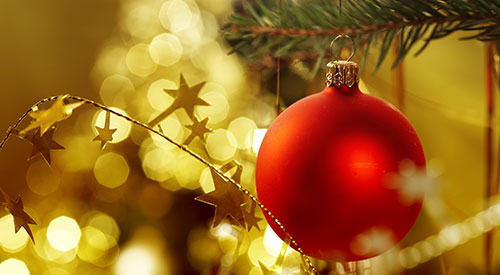
(PCM) It is the time of year where we are ready to deck the halls and begin trimming our Christmas trees. For many families this is time for togetherness and one of the most enjoyable aspects of the impending holiday season. The tradition of the Christmas tree as we know it today began here in America in the early 1700’s, however the Christmas tree itself dates back to 15th and 16th century Germany. Evergreens were used first in church plays at Christmas and were hung with apples to symbolize a Paradise tree. Paradise trees later found their way into homes, where they were adorned with small white wafers, and later, small pastries cut into stars, angels, hearts and flowers.
The custom of the Christmas tree began to spread from Germany throughout the rest of Europe and eventually fully decorated trees were brought to America by German mercenaries who were battling in the Revolutionary War. Due to Puritan influence, Christmas was not fully celebrated in America until later in the 1800’s . Decorated trees did not become widely popular until people saw the ornaments brought to America by families emigrating from Germany and England in the 1840s.
Ornaments were not something that was widely available in America and most were shipped over from Germany. They were incredibly elaborate and often times made out of hand-blown glass, lead, with silk and wool threads. Early Christmas trees were also lit with tiny candles in small brass holders rather than the modern electric lights that we find on trees today. One can only imagine the danger of using actual lit candles on a dry wooden tree. Looks like we can thank dear Thomas Edison once again!
The early 1800s also saw real fruit used to decorate the Christmas tree as it symbolized items that would grow on trees and also symbolized the regeneration of life looking forward towards the spring season. Each year that passed more and more traditions were added to decorating the Christmas tree. In America they began stringing popcorn and dried cranberries to use as garland around the tree. Small gifts were other items that began to be hung on the trees, sometimes contained in small hand-crafted baskets, in fact these small trinkets became such a popular way to decorate the tree that often times Christmas trees were filled with so many of them you almost could not see the actual tree underneath … sound familiar!
Folklore and legends also play an important role in the the Christmas tree ornaments extensive. The popular German pickle ornament carries with it a wonderful tale. Pickle ornaments are glass ornaments formed in the shape of a pickle. The German parents used it to judge the most intelligent child in the family. The first one to trace the pickle got an additional gift from St. Nicholas. Other popular ornament designs include stars which represent the Star of Bethlehem which guided the three wise men to Christ, bell which are said to bring back lost sheep to their flock, bows which represent everlasting goodwill and of course wreath’s which represent God’s eternal love.
F.W. Woolworth, an early American mass merchandiser, began importing German glass ornaments into the country in the 1880s. By 1890, he was reportedly selling $25 million worth of them. According to Wikipedia, the first American-made glass ornaments were created by William DeMuth in New York in 1870 in conjunction with the Corning company most well-known for their collection of glass bake ware. Although glass ornaments are still produced, as expensive good quality ornaments often found at markets, ornaments are now frequently made from plastic and available worldwide in a huge variety of shapes, colors and designs. In 1973 the American Hallmark Company first launched the Keepsake Christmas ornaments that revolutionized the ornament industry as we know it today. Once a collection of decorated glass balls and yarn figures, keepsake ornaments are now found in a wide variety of wood, acrylic, bone china, porcelain and other hand-made materials.
The post The Origins Of The Christmas Ornament appeared first on Pop Culture News.
